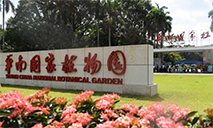Forest farm in SW China's Guizhou continues to thrive thanks to endeavors of several generations of forest rangers
Thanks to the endeavors of several generations of forest rangers, the Changpoling forest farm in Guiyang, capital of southwest China's Guizhou Province, has become an important part of the city’s ecological buffer zone.

Photo shows the Changpoling forest farm in Guiyang, capital of southwest China's Guizhou Province. (Photo/Tu Min)
Lying to the north of the older districts of Guiyang, the forest farm covers an area of nearly 13,000 mu (about 866.67 hectares) of land. With 86 percent of its total area covered by forest, it is home to 397 wild animal and plant species.
Born in 1963, Guo Maochun, a worker employed on the forest farm, has been working here since 1983. Guo, whose father was also a forest ranger in Guiyang back in the day, recalled that his father had come there to plant trees in 1958 after joining in the national afforestation drive. “Back then there were only barren mountains, with some covered by rocks. People had no choice but to go up the hills carrying the saplings on their backs,” said Guo.
The main task of Guo and his colleagues shifted to protecting the forest, as the saplings planted by their predecessors eventually grew into tall trees. Thanks to their thoughtful care, the tree farm was gradually transformed into a lush forest in the early 1990s. The timber produced at the site meanwhile became very popular for use in various construction projects.
Over the course of a few years, a larger number of transportation facilities were completed, which was able to connect the tree farm with the neighboring city of Guiyang. “New bus routes were opened, allowing more people living in the city to go on a trip here,” introduced Tian Feng, a forest ranger who started to work at the site in 1995. The tree farm went on to gain the status of a provincial-level forest park and officially opened to visitors in 1997.
In 1998, the forest park abandoned its timber production activities in an attempt to better protect the forested area. Three years later, the site was listed as a national-level forest park.
But unfortunately, the favorable ecological environment of the forest park was negatively impacted by the growing number of businesses operating in the area, such as barbecue stalls. The large expanse of green lawns that once dominated the landscape there was reduced to a muddy stretch of well-trodden ground, while the surrounding trees withered due to the excessive smoke of the barbecue stalls dotting around the forest’s edge. Tian, who returned to the forest park as its new head in 2015, decided that “efforts must be made to stop this!”
Then the forest park worked to restore its environmental integrity, making the mountains green again and turning the businesses there into environmental education halls for the benefit of incoming visitors to the park. Since March 2022, the forest park has offered free admission to visitors, attracting an even larger number of residents living in Guiyang.
“I can get closer to nature here. And this is the forest park as it should be!” said Xu Gongbiao, a local resident. Xu usually spends weekends there with his friends, either walking in the park or enjoying some tea there.
The forest park is an epitome of the city’s various efforts aimed at ecological restoration. With parks, scenic areas and over 100 tree farms constructed in parallel with Changpoling, Guiyang built its first green buffer zone stretching 70 kilometers in 1990. Now the city is home to 1,025 parks of all kinds.
Photos
Related Stories
- Forest Law builds legal protection for ecology
- Forest areas expand and ecological resources improve in China: authority
- China Forestry Group to plant over 40,000 hectares of forests nationwide
- Pic story of forest rangers of Mangshan Mountain in Beijing
- Chinese bank ups loan support for forest carbon sink capacity
- Natural colors of the forest
- UN chief calls for "tangible and credible" forest management
- Forest ranger in north China’s Inner Mongolia musters renewed determination to protect local environment
- “Ecological bank” in China increases people’s income while promoting better development of forest resources
- Inner Mongolia to afforest over 733,300 hectares of land
Copyright © 2022 People's Daily Online. All Rights Reserved.









